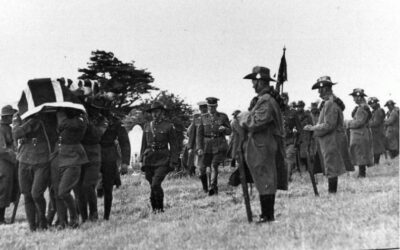Born: 16 April 1828 at Killeter, Tyrone, Northern Ireland
Died: 15 October 1909, Mount Gambier, South Australia
Parents: Samuel John Caldwell and Mary Wilson Caldwell.
Spouse: Sarah Jane Hackney
Rev. Caldwell trained at Queen’s University Ireland and at Assembly’s College Belfast. He was chosen as “The Student’s Missionary “to labour in the west of Ireland, and was for some years minister at Boyle, County Roscommon.
Rev. Caldwell married Sarah Jane Hackney of Kilcolman, County Limerick on 3 August 1858
At a meeting of the Presbytery in February 1864, the Rev. James Don intimated his intention to accept the call to Penola. An application was made through the Presbytery for a supply, and as a result of this the Rev. R.A. Caldwell, who had only a few months arrived from home, was sent to Mount Gambier. He conducted the services for the Church for the first time on March 27, 1864. On that occasion, as well as on succeeding Sundays, he so satisfied the congregation that it was unanimously resolved to invite him to accept the position. He accepted the call and on Wednesday, August 3rd, 1864, he was duly inducted as pastor.
Mr. Caldwell was a familiar character in the district as he drove his buggy and horses to all corners of his parish – Port MacDonnell, Tarpeena, Dartmoor, Strathdownie, Yahl, Glencoe and some other smaller communities.
An interesting article published in the Border Watch tells of a presentation made to Rev. Caldwell after Bible Class which had been conducted in the Square Mile Schoolhouse. Mrs. O Unger on behalf of the class made the presentation of a large travelling rug. This rug was made of carefully selected fox skins, measuring over 6 ft. one way and 6 ft the other. It was edged with fox tails sewed longitudinally and beautifully lined in blue, with gold binding. The skins were selected for richness of color and density of fur.
Rev. Caldwell oversaw the extension of the existing church, and later the erection of the current church. St. Andrew’s was opened on December 10, 1871. 1877 saw the purchase of an Organ for the Church at a cost of £55. At this time a thorough overall of the Manse incurred a cost of £142, with a further amount of £153 being spent on fencing. In 1885 the Church tower was deemed unsafe. It was decided to have it pulled down and 10 feet added to the spire to afford the opportunity to have a bell installed. It was at this time that the new stables and outbuildings were erected behind the manse.
In 1879 Mr. Caldwell’s salary was raised to £400 per annum. In 1889 the Congregation felt it would like to show some tangible appreciation of the work done by Mr. & Mrs. Caldwell. In that year Mr. & Mrs. Caldwell were presented with an illustrated address and 500 sovereigns so they may visit Europe and the old country. After sufficient leave was granted, they set out on May 10, 1889. After 44 years of service Mr. Caldwell was presented with a congratulatory message and 108 sovereigns.
Rev. Caldwell resigned on 31st March 1909, and he died on 15th October 1909 at the age of 82 years. The Church Minute Books record “That a record be made of the high sense entertained of the services rendered to this Church by the Rev. R.A. Caldwell for over 45 years. Mr. Caldwell was an earnest and enthusiastic worker, a zealous preacher of the gospel, and a warm and sympathetic friend to all the people. He did whatever he had to do with all his might, and we rest assured that he has now entered into his rest. The Master has given him the welcome: “Well done, good and faithful servant, enter thou into the joy of thy Lord”.
The funeral procession left shortly after the conclusion of the service in St. Andrew’s Church. The Church grounds, Elizabeth and Jane Street were crowded with vehicles. Mr. G.B. Renfrey, one of the Funeral Directors, arranged the vehicles in double lines. The cortege was by far the largest ever seen in Mount Gambier. It contained over 200 vehicles, most of them full. Members of every denomination at Mount Gambier were there. When the cortege reached the cemetery gate there was over a hundred more vehicles were tied up along the roads adjacent. The road through the cemetery was closely lined with people to the grave. The hearse was driven right up to the grave, around which over 2,000 people were crowded.
Steps were soon taken to erect a suitable monument to Mr. Caldwell. It took the form of a granite monument which was subscribed for by the Congregation and townspeople and erected in the Lake Terrace Cemetery.
Resources – St. Andrew’s 100 years Book: St. Andrew’s 70 year Historical review Souvenir.
Trove (National Archives): The Border Watch.
State Library of South Australia – Reverend Robert A Caldwell [B3073] – Photograph





